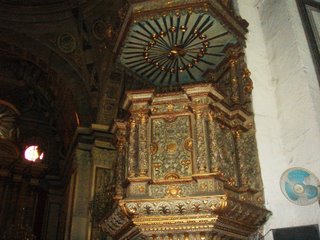'Death to their God!'
As a kid, I just loved watching Cecil B. DeMille's 'The Ten Commandments'. We had it on VHS on 'extended loan' from my grandparents, and everytime I would get the chance I would play the second half of the movie, when Moses finally summons the guts and confronts the Pharaoh about God's demand, that he 'let My people go'. I had fond memories of the incomparabley villainous Yul Brynner, in full royal vestments, literally a god to his people, confronting this old, dishevelled husk of a man whom he once considered his brother. Yes, I know all about the creative license the producers took with the Biblical narrative, but today, the kitschyness of the film still gets me. Nothing beats that classic line, 'Your fragrance is of the wine of Babylon'. Pure genius.
Of course, the title of this post refers to the Pharaoh's infamous remark, when he decides to give chase to the Israelites and bring them to slavery once more. Here was a classic line that expressed the ancient Egyptian Pharaoh's sentiment of superiority and divinity, crystalllized and distilled of any sort of pretentiousness, a raw challenge, as it were, from one god to Another.
Well, doesn't this just remind you of that scene?
They Have No Decency
Too many in media bash Catholicism - and get away with it
By WILLIAM A. DONOHUE
She's a mother who is very protective of her children. She is a believer who accepts the tenets of her faith. And yet, she continues to vent her hatred of all things Catholic. She's Madonna.
In her "Confessions" tour, the former Catholic and now practicing member of kabbalah appears with a crown of thorns while suspended from a giant mirrored cross. It's vintage Madonna: She went back to the well of anti-Catholicism one more time, proving that the old diva cannot dance and sing without exploiting Catholic iconography.
It's not just her. In February, hip-hop artist Kanye West graced the cover of Rolling Stone wearing a crown of thorns with "blood" streaming down his face. The piece, titled "The Passion of Kanye West," divulged the rapper's passion for pornography. It also revealed the Catholic-bashing agenda of the magazine and the musician.
It may be that "The Da Vinci Code" is one of the most inane movies to appear in some time, and it may be that its failure to persuade means Catholics have nothing to worry about. But if so, this is by default. After all, the book upon which the film is based is built on malicious lies about the Catholic Church.
One of the co-producers of "The Da Vinci Code," John Calley, was quoted last year saying the movie was "conservatively anti-Catholic." Leaving aside the silly qualifier, ask yourself: Is there a single producer in all of Hollywood who would boast that his movie is anti-Semitic, racist or homophobic? And to top it off, ask yourself why inoffensive depictions of Muhammad are rarely shown on TV or in newspapers?
The bias against Catholicism is palpable. No other segment of society is continuously the target of vicious jokes by the likes of Penn Jillette or Bill Maher. No other segment of society is subjected to the obscene assaults like those "South Park" delivers over and over again. And no other segment of society is routinely held up to derision on college campuses.
Consider that a student newspaper at the University of Oregon recently put a depiction of a naked Jesus Christ on the cross with an erection. It also showed a graphic of a naked Christ kissing a naked man, both sporting erections. And the response from the university's president? It was so weak that state lawmakers — after receiving color copies of the offensive pictures from the Catholic League — have decided to deal with this incident themselves. All because the president of the university found it politically incorrect to morally condemn the newspaper.
It's not just Catholics who are on the receiving end of these attacks — all Christians are fair game. NBC dumped "The Book of Daniel" because there was no audience for the script, but the producers surely thought there would be one. After all, who wouldn't want to watch a show where an Episcopalian priest dabbles in drugs, the wife is a boozer, the daughter is a dope dealer, one son is gay, the other is a womanizer, the brother-in-law is a thief and the father's father is an adulterer? Just your ordinary Christian family — in the eyes of Hollywood, that is.
To understand what's driving this, consider that our culture teaches that freedom means the right to do whatever we want to do and Catholicism teaches that freedom means the right to do what we ought to do. There's a natural disharmony here, a tension so taut that something's got to give. Never mind that a libertine idea of freedom — liberty as license — is spiritually, psychologically, physiologically and socially deadly in its consequences. It's what sells. Sadly, what is attendant to this perverse interpretation of liberty is a need to lash out at any creed that preaches the virtue of restraint.
The scandal in the Catholic Church did not help matters, but the frontal assault on Catholicism antedated the revelations of 2002. No matter, the kind of hate speech that spews with regularity toward the Catholic Church can never be justified. That it occurs amid all the chatter about tolerance and respect for diversity makes it all the more repugnant.
Donohue is president of the Catholic League for Religious and Civil Rights.
This story originally appeared on The New York Daily News on 23 May 2006
I'm hardly surprised. Hollywood is perhpas the most godless place in the world, yet at the same time, it is god to many people drawn to the life of prestige and immeasurable wealth it offers. It regularly vomits forth films that are thinly-disguised attacks on the Church, starring, of course, equally godless men who will be reduced to dust and ashes in a matter of years. Yet they have the gall wo parade themselves as gods, perhaps convinced of their own immortality. Just look around you. Watch a couple of movies. The Catholics are always depicted as superstitious, ignorant of their own faith, and devoid of morals. Catholic priests are always sleaze bags, gluttons, alcoholics, homosexuals, bigots and the like. Irony of ironies, however, the only good depiction of Catholics can be found in Horror movies. Mostly. When there's a question of some weird, obscure prophecy or the date of the Anti Christ's birth, the Church is always depicted as the one with all the answers. Yet how the world vilifies Her.
'Tis a far cry from the 50s or 60s when Catholics were treated with respect. Have you ever seen Alfred Hitchcock's 1953 classic, 'I Confess'? It was an excellent film which plays on themes sacred to Catholics like the seal of the confessional. The priest is depicted as a man of conviction, dignified, as opposed to the bastardized portrayal of priests found in films today.
Even 'The Exorcist', for all its expletives and controversial scenes, depicted Frs. Merrin and Karas as men worthy of respect, men who were really concerned with exorcising the demon out of young Reagan.
*Sigh*. Isn't it odd that Hollywood, sans one 'l' and given a space in the middle, spells out the words 'Holy Wood'? An obvious reference to the Cross of Christ, 'in quo salus mundi perpendit'-- on which hung the salvation of the world. It is indeed lamentable that we are crucifying our own Saviour by tolerating these things.




























